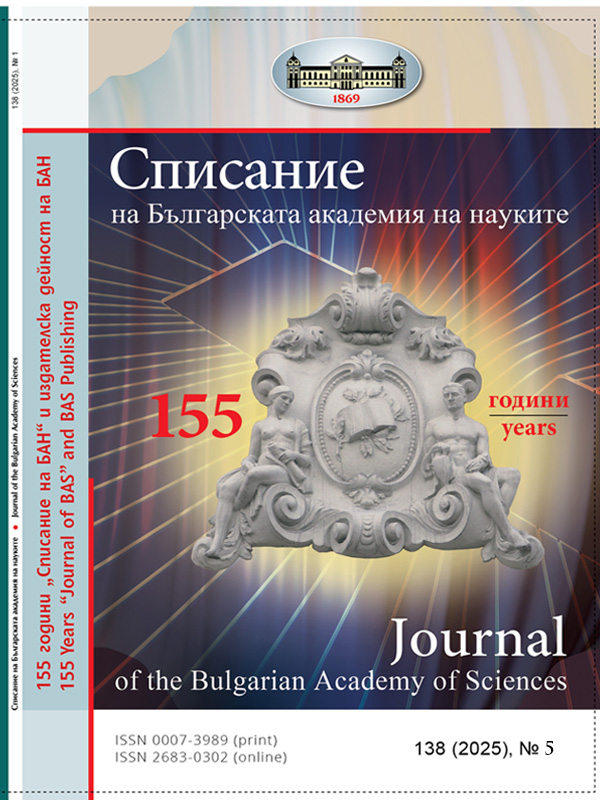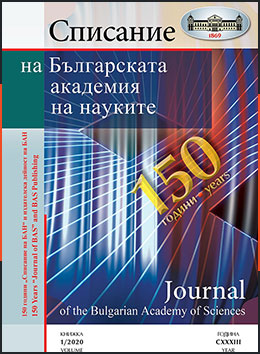Current Issue Published
Journal of the Bulgarian Academy of Sciences
- Year: 2025
- Number: 5
- Language: Български, English
- Download Issue

- Declaration in Defense of the Interests of Scientists at Risk of Losing Their Dormitory Housing
-
The Spiritual Image of Bulgarian Science (155 Years “Journal of the Bulgarian Academy of Sciences”)
Author(s): Yachko Ivanov
-
The Reviving Sunrise
Author(s): Georgi MarkovAbstract: The Ottoman conquest of the Balkans separated the region from Renaissance Europe and delayed its economic and cultural development by centuries. Christians were declared “infidels” and treated as “second-class” subjects. The Bulgarians did not resign themselves to the rule of the oppressors and, during the 18th century and the first quarter of the 19th century, rose in a series of uprisings to reclaim their freedom and rights, which resonated across other European countries. These uprisings were usually linked to the wars of the Habsburg Monarchy and Russia against the Ottoman Empire, and, accordingly, to their strategic interests in Southeastern Europe. The resolution of the Eastern Question brought about both cooperation and confrontation between the Great Powers, directly affecting the fate of the Balkan peoples. At the same time, the high-level politics surrounding the struggle for the “Ottoman legacy” proved deeply selfish, and the disappointments far outweighed the long-nurtured hopes for support from either the West or the East. The economic empowerment of the Bulgarian artisan and merchant class, and opening their eyes to enlightened Europe, gave fragile hopes for the distant future, but foreign oppression hindered full integration into universally recognized values. The church-run schools (known in Bulgarian as “kiliyni uchilishta”) continued to educate children in a religious spirit. They preserved Bulgarian teaching aids and books, reminding new generations of their ancestral roots. With the support of guilds, schools affiliated with every church were maintained in towns and large villages. Gifted children were sent abroad to continue their education. Although exiled outside Bulgaria, the scholars never ceased to think and write about their longsuffering homeland: Georgi Pejačević in Transylvania, Krastyo Peykich in Vienna, Partheniy Pavlovich and Hristofor Žefarović in Sremski Karlovci. Foreigners also published books on Bulgarian history, including Ivan Saski in Moravia, Joseph Assemani and Franz Pejačević in Rome, and Blasius Kleiner in the Vatican. The rays of national awakening shone from Mount Athos, where Hieromonk Paisius of the Hilendar Monastery wrote Slav-Bulgarian History around 1762. In its pages, not only does Bulgaria’s glorious past reflect like in a deep well, but also paths toward national self-awareness and liberation are outlined. The hunger for more historical knowledge led to the appearance in 1792 of another Brief History of the Bulgarian People by Hieromonk Spiridon in the Rila Monastery – with a an expanded range of sources and hard-earned lessons. Among the devoted followers of Paisius of Hilendar, Sophronius of Vratsa stands out, whose life confession Life and Sufferings of Sinful Sophronius reveals the burdens and efforts of a national awakener. The most important merit of the enlightener Sophronius was the construction of the modern Bulgarian literary language based on the spoken language of the people and the publication of the collection Nedelnik with teachings for holidays and weekdays. The priest from Kičevo Joachim Karchovski published books connecting morality with enlightenment, while the monk from Tetovo Kiril Peychinovich wrote books to bring teachings and instructions closer to everyday life. In Thessaloniki, Theodosius of Sinai printed booklets in “simple and concise Bulgarian for the reasonable common people”. The spread of printed books among the people gave a strong impetus to the Revival because of the accessibility of knowledge and the possibility of its timely acquisition. “Reading and writing” would help the next generations of Bulgarians realize that alongside bread, freedom is vitally necessary for their dignified existence, and the apostles would first be teachers and then revolutionaries.
-
The Early Journalism of Exarch Stefan (Stoyan Popgeorgiev)
Author(s): Stoyan RaychevskiAbstract: Exarch Stefan – Metropolitan Stefan of Sofia (secular name Stoyan Popgeorgiev) was born on September 7, 1878 in the village of Shiroka Laka, Devin Municipality. In 1898 he graduated from the Theological Seminary in Samokov, in 1904 from the Theological Academy in Kiev with the title of ‘Candidate of Theology’ with the dissertation entitled ‘Review of the Relations between the Bulgarian and Roman Catholic Churches from the Time of the Conversion of the Bulgarians to the Establishment of the Exarchate 864 – 1870’. He specialized at the Protestant University of Geneva, and then at the Catholic University of Fribourg in Switzerland, where he graduated with a degree of ‘Doctor of Philosophy and Literature’ with a dissertation ‘On the Bogomils and Cosmas the Presbyter’. He was appointed the first professor of Homiletics and Pastoral Worship at the newly established Theological Academy in Sofia. On March 22, 1922, he was elected Metropolitan of Sofia. From 1918 to 1938, he regularly participated with reports at the World Conferences of Churches in Geneva, Copenhagen, Lausanne, Paris, Bern, Oslo, London, Avignon, Cambridge, Copenhagen, Oxford and other European cities, where he appeared as a talented speaker and supporter of the movement for peace through the churches. He was elected chairman of the World Council of Churches, one of the conferences of which was held in Sofia (1933). With his international authority, Metropolitan Stefan of Sofia contributed to the admission of Bulgaria to the League of Nations and was appointed by the same as Commissioner for Refugees. His great merit was in granting the Refugee Loan to Bulgaria after the First World War, in 1943 – for saving Bulgarian Jews from deportation, and at the end of the Second World War – for overthrowing on March 13, 1945, the schism imposed in 1872 by the Patriarchate on the Bulgarian Orthodox Church. On December 18, 1945, Metropolitan Stefan of Sofia was elected and canonically confirmed as Bulgarian Exarch. By Decree No. 29 of the Council of Ministers of 17.09.1948, Exarch Stefan was forced to part with his high pastoral post as head of the Bulgarian Orthodox Church and was interned in the village of Banya, Karlovo Municipality, where he remained until the end of his life. He died on May 14, 1957 in isolation from church, cultural and public life. Bulgarian Exarch Stefan I left behind a rich archival and literary heritage. Here I present his early journalism from the period before his monasticism and his church activity, when he signed himself with his secular name or with pseudonyms. He made his first appearances as a publicist in the newspaper ‘Savetnik’, in which he collaborated regularly for several years on current problems in Bulgarian society regarding morality, faith, education, science and public relations, in which he not only expressed his views, but also led polemics with authors on philosophical, historical, moral and church issues from the position of a convinced defender of the traditions and faith of his people. Even in his first publications, his inclination towards polemics and his good command of the word, as well as his good education, are evident. He signed himself as Stoyan Popgeorgiev, but sometimes as Shokov (his family name), Shinin (after the name of his mother Shina) or Maliy, Chernorizets, etc. He also collaborated very actively with the Lyuboslovie magazine, published under the editorship of Alexander Teodorov Balan, in each issue of which he published even more extensive articles. It is also worth noting the fact that even as a novice publicist he found a platform on the pages of the capital’s publications, especially the Lyuboslovie magazine, where at that time authors such as Dr. Krastev, Ivan Vazov, Pencho Slaveykov, Anton Strashimirov and others were published.
-
Scientism vs. Esotericism and the Teaching of Peter Deunov
Author(s): Dimitar KalevAbstract: This article explores the epistemological models embedded in the doctrine of Peter Deunov (Beinsa Douno), traditionally interpreted as a form of esoteric Christianity, through the conceptual polarity of esotericism and scientism. The central hypothesis suggests that Deunov’s occult gnoseology is situated within a discursive field shaped by three core postulates in his teaching: (1) Love as a force acts through the mind; (2) Divine Love brings the fullness of Life; and (3) I think in the way God thinks. The methodological framework adopts the premise that the Idea constitutes the sole object of cognitive thought, from which all classical and modern epistemological models emerge–bifurcating toward either rationalism (contemporary scientism) or psychism (esoteric knowledge). Particular emphasis is placed on the gnoseological nature of contemplative judgments and the contemplative force of Love as operative within them. The phenomenology of socalled “metamorphic judgments” is examined as a dynamic stream of self-generating imaginations and the genesis of ideal objectivity. In conclusion, the article outlines three epistemological models implicitly present in Deunov’s scientific-practical postulates, each corresponding to distinct meditative techniques and mystery-oriented practices.
-
The Bulgarian Unification
Author(s): Hristo Hristov
-
Fragments from the Personal Life of Ivan Vazov
Author(s): Lisbet Lyubenova
-
Looking into the Future, Academician Petya Vassileva Turns 85
Author(s): Hristina Grupcheva
-
An Alternative Interpretation of the Underground Man
Author(s): Peter Popivanov
- BAS and NATFA Signed a Memorandum of Cooperation
- Donation of Books from the Personal Library of the Former Mayor of Sofia, Eng. Ivan Ivanov
- The Restored Second Statue from Heraclea Sintica – Exhibited for the First Time at the National Archaeological Institute with Museum of BAS
-
The Aristocratic Irony of Lyuben Zidarov
Author(s): Ivan Granitski
-
Elin Pelin and the Bulgarian Idea of Freedom after the Liberatio
Author(s): Panko Anchev
- In Memory of Academician Stefan Vodenicharov (5 Years since the Death of Stefan Vodenicharov)
Journal of BAS
ISSN 0007-3989 (print)
ISSN 2683-0302 (on line)
150 Years
"Journal of the BAS"

Sections in the Issue
In the issue you can read articles from the following sections.
